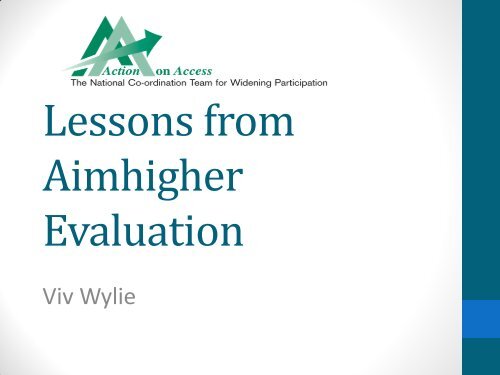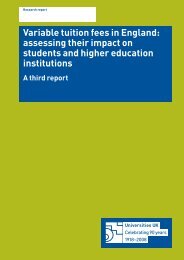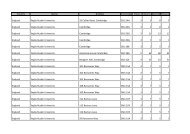Dr Viv Wylie, Consultant, Action on Access ... - Universities UK
Dr Viv Wylie, Consultant, Action on Access ... - Universities UK
Dr Viv Wylie, Consultant, Action on Access ... - Universities UK
- No tags were found...
You also want an ePaper? Increase the reach of your titles
YUMPU automatically turns print PDFs into web optimized ePapers that Google loves.
Less<strong>on</strong>s fromAimhigherEvaluati<strong>on</strong><str<strong>on</strong>g>Viv</str<strong>on</strong>g> <str<strong>on</strong>g>Wylie</str<strong>on</strong>g>
Aimhigher:what was it?• Nati<strong>on</strong>al initiative delivered at local level• Aim to increase numbers of disadvantagedlearners entering HE, and learners withdisabilities• Target group largely young learners <strong>on</strong> C/Dborderline re GCSE achievement – not fordisadvantaged highfliers• Focus <strong>on</strong> outreach, partnerships, learnerprogressi<strong>on</strong>, integrated programmes
Evaluati<strong>on</strong>• Annual m<strong>on</strong>itoring from outset• Annual evaluati<strong>on</strong> from 2008 in accordance with nati<strong>on</strong>almodel.• Rigorous targeting using IMD/NSSEC data and engagingLAs and teachers• Use of KPIs - GCSE results, c<strong>on</strong>tinuati<strong>on</strong> and progressi<strong>on</strong>rates• Use of qualitative data – focus groups, questi<strong>on</strong>nairesinvolving learners, teachers, parents to informquantitative data and dem<strong>on</strong>strate attitudinal shift• Increasing focus <strong>on</strong> VFM as KPI
What happened?• Difficult to impose standard model <strong>on</strong> diversity ofpartnerships with differential funding and locallyinflected provisi<strong>on</strong>• Data collecti<strong>on</strong> was <strong>on</strong>erous. Data sharing was frequentlydifficult. Criteria for disadvantage were problematic.Many but not all partnerships worked through the issues.• Systems had to be developed quickly especially fortracking – probably most robust in larger partnershipsand at regi<strong>on</strong>al level.• Partnerships found that good evaluati<strong>on</strong> shared withpartners was a powerful tool for improvement andencouraged participati<strong>on</strong> in the process
Outcomes• Aimhigher evidence focused <strong>on</strong> the student rather than theactivity• Tracking seemed to show that the more students participatedthe more they improved their achievement at GCSE.C<strong>on</strong>tinuati<strong>on</strong> and progressi<strong>on</strong> rates also improved.• Participati<strong>on</strong> in intensive activities (mentoring, summerschools) was most effective in raising aspirati<strong>on</strong> (cf individualevaluati<strong>on</strong>s)• Qualitative evidence appeared to show that Aimhigheractivities built c<strong>on</strong>fidence, increased knowledge andunderstanding of HE, improved motivati<strong>on</strong> and so impacted<strong>on</strong> achievement.• Some evidence showed a positive impact <strong>on</strong> school culturesand a greater understanding am<strong>on</strong>g teachers of the potentialof the target group.
But….• The discrete “Aimhigher effect” could not be proved butthere was a str<strong>on</strong>g associati<strong>on</strong> between improvedoutcomes for learners and Aimhigher programmes.• Methodologically there were flaws – no c<strong>on</strong>trol groupand too much diversity within generic activities• Where integrated programmes were effective it wasimpossible to tell what improvements were due toschools’ interventi<strong>on</strong>s and what to Aimhigher activities.• What could be asserted was that there was evidencethat the Aimhigher cohort performed better <strong>on</strong> a rangeof KPIs than their peers and that stakeholders attributedchanged behaviours to Aimhigher support.
Now?• Different c<strong>on</strong>text – more diversified, smaller scaleoperati<strong>on</strong>s, fewer partnerships• Competitive envir<strong>on</strong>ment• Widening participati<strong>on</strong> addresses student lifecycle• Evaluati<strong>on</strong> smaller scale, more focused <strong>on</strong> manageableoutcomes, and with methodologies devised by HEIsrather than to nati<strong>on</strong>al models• But nati<strong>on</strong>al framework for evaluati<strong>on</strong> proposed ininterim report by HEFCE and OFFA
Less<strong>on</strong>s forOutreach• Build in evaluati<strong>on</strong> from the outset: define what you want toknow and what evidence you will require• Focus <strong>on</strong> the learner and <strong>on</strong> attitudinal change together witheffectiveness of activities. Track where possible. Usequalitative evidence to link interventi<strong>on</strong>s with raisedaspirati<strong>on</strong>s and attainment.• Target stringently – enlist help of schools to refine targeting atpupil level• Evaluate partnerships and positive change within schoolcultures• Explore the Aimhigher thesis that more participati<strong>on</strong> leads togreater improvement in attainment• Remember that evaluati<strong>on</strong> takes time to deliver useful results.
















